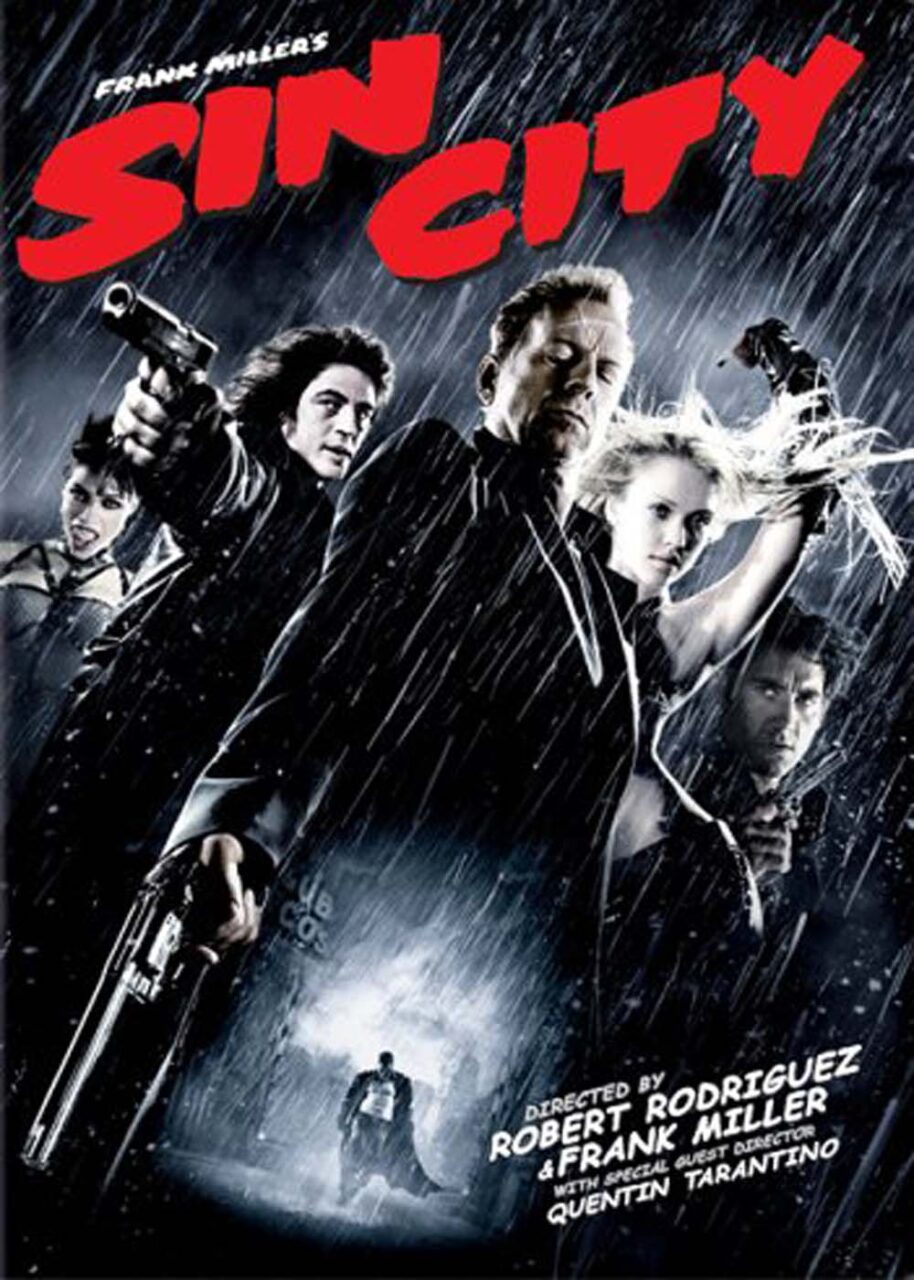USA. 2005.
Crew
Directors – Frank Miller & Robert Rodriguez, Special Guest Director – Quentin Tarantino, Based on the Sin City Graphic Novels The Customer is Always Right, That Yellow Bastard, The Hard Goodbye & The Big Fat Kill by Frank Miller, Producers – Frank Miller, Robert Rodriguez & Elizabeth Avellan, Photography (b&w + colour tint)/Visual Effects Supervisor – Robert Rodriguez, Music – Robert Rodriguez, John Debney & Graeme Revell, Visual Effects – Cafe FX (Supervisors – Everett Burrell & Jeff Goldman), Hybride Technologies (Supervisor – Daniel Leduc) & The Orphanage Inc (Supervisor – Stu Maschwitz), Pre-Visualization – Troublemaker Digital Studios, Special Effects Supervisor – John McLeod, Makeup Effects – K.N.B. EFX Group Inc (Supervisors – Howard Berger & Greg Nicotero), Art Direction – Jeanette Scott. Production Company – Dimension Films/Troublemaker Studios.
Cast
The Customer is Always Right:- Josh Hartnett (The Man), Marley Shelton (The Customer). That Yellow Bastard:- Bruce Willis (Detective John Hartigan), Jessica Alba (Nancy Callahan), Nick Stahl (Junior Roark), Michael Madsen (Bob), Powers Boothe (Senator Roark), Makenzie Vega (Nancy Age 12). The Hard Goodbye:- Mickey Rourke (Marv), Jaime King (Wendy/Goldie), Elijah Wood (Kevin), Carla Gugino (Lucille), Rutger Hauer (Cardinal Patrick Roark). The Big Fat Kill:- Clive Owen (Dwight McCarthy), Benicio Del Toro (Iron Jack/Jackie Boy Rafferty), Rosario Dawson (Gail), Brittany Murphy (Shellie), Alexis Bledel (Becky), Devon Aoki (Miho), Michael Clarke Duncan (Manute)
Plot
The Customer is Always Right:- A smooth young man charms a beautiful woman in a red dress. That Yellow Bastard:- Police detective John Hartigan is about to retire due to health conditions. Despite a bad heart, he relentlessly pursues Junior, the son of the wealthy Senator Roark, who has abducted twelve year-old Nancy Callahan with the intent of raping, torturing and killing her. Hartigan is determined to kill Junior Roark, despite his father’s influence making him untouchable. The Hard Goodbye:- The brutish and hulking Marv spends a night with the beautiful Goldie, only to wake in the morning and find her dead body in bed beside him. Wanted by police for the murder, Marv determines to personally avenge her murder. This takes him on a trail that leads to a cannibal killer who is protected by the most powerful authorities in the city. The Big Fat Kill:- Jackie Boy and his friends force their way into the apartment of the exotic dancer Shellie but are driven out by her new boyfriend Dwight McCarthy. Dwight pursues the group into Old Town, the part of Sin City where the prostitutes rule according to their own laws. The prostitutes kill Jackie Boy and his entire group for having treated Shellie badly. Dwight then discovers that Jackie Boy and the others are cops. He rushes to dispose of the bodies before the rest of the police find what the prostitutes have done and come to massacre them. That Yellow Bastard cont:- For brutalizing his son, Senator Roark has Hartigan sent to jail for eight years on charges of child molestation. The whole time, Nancy secretly writes to Hartigan, always disguising the details of where she is. But then the letters suddenly stop and Hartigan is delivered a severed finger. He agrees to a guilty confession so as to be released and sets out to find Nancy. He discovers that she is now an exotic dancer in Old Town. She tells him that she has always loved him. However, the mutilated Junior Roark has manipulated this as a pretext to track down and eliminate Nancy.
In the modern world of comic-book fandom, Frank Miller is a name that has ascended to a revered status. Miller began working as a comic-book artist and writer, shifting between Marvel and DC Comics. There his work on both Daredevil and Batman ended up redefining both series. His darker reinvention of Daredevil gave a new popularity to a character that had languished on Marvel’s sidelines for several years. In particular, Miller’s graphic novel The Dark Knight Returns (1986) gave birth to the dark, angst-ridden Batman and created a look that has cast a giant shadow over the interpretation of all modern superheroes. In between his mainstream work, Miller began to increasingly work as an independent where he created a number of his own graphic novel series including Give Me Liberty (1990), Hard Boiled (1990-3) and 300 (1998). The most famous of these was the Sin City series of graphic novels that Miller wrote for Dark Horse between 1991 and 2000. These have consisted of five long and twelve shorter stories that have been variously serialized or sold in compilations. All of these take place in the fictional setting of Basin City, a deliberately stylised setting drawn from film noir, and feature a cast of characters who weave in and out of each other’s stories.
Frank Miller’s work has appeared on screen before. He is credited as screenwriter on both RoboCop 2 (1990) and RoboCop 3 (1993). His interpretation of Marvel’s Daredevil was a strong influence on the movie adaptation of Daredevil (2003) and in particular its spinoff Elektra (2005), which was a character that Miller originally created. Miller had no hands-on experience with either film and his experience on the RoboCop films was reportedly a negative one, with his ideas being rewritten, such that he afterwards swore off allowing Hollywood to touch any of his properties.
All of that changed with Robert Rodriguez. Robert Rodriguez is surely the filmmaking equivalent of the Energizer Bunny. He first appeared in 1993 at age 24 with the cod-Spaghetti Western El Mariachi (1993), for which he performed almost every function on screen (directing, writing, producing, shooting, editing, acting and raising the finance himself). Both El Mariachi and its studio-backed sequel/remake Desperado (1995) are infused with an enormously fresh and vibrant energy that immediately signalled Rodriguez as one of the most promising new directors of the decade.
Not long after, Rodriguez discovered genre cinema and has remained there fairly much ever since, first with the vampire film From Dusk Till Dawn (1996) made in collaboration with good friend Quentin Tarantino, and then the witty alien body snatchers film The Faculty (1998), the highly enjoyable children’s film Spy Kids (2001) and Planet Terror (2007), his half of Grindhouse (2007), the children’s film Shorts (2009) and much of Machete Kills (2013). Rodriguez has continued to expand, desiring to put his hands on almost every single aspect of production – directing, writing, producing, photographing, scoring, editing, operating camera, sound editing, supervising the visual effects and designing the sets on his films, as well as setting up his own studio in Austin, Texas. On the minus side, this manic hyper-activity has begun to show through on some of his more recent films – Spy Kids 2: Island of Lost Dreams (2002), Once Upon a Time in Mexico (2003), Spy Kids 3-D: Game Over (2003), The Adventures of Sharkboy and Lavagirl in 3-D (2005) and Spy Kids: All the Time in the World (2011) – which have started to seem a little thin creatively.
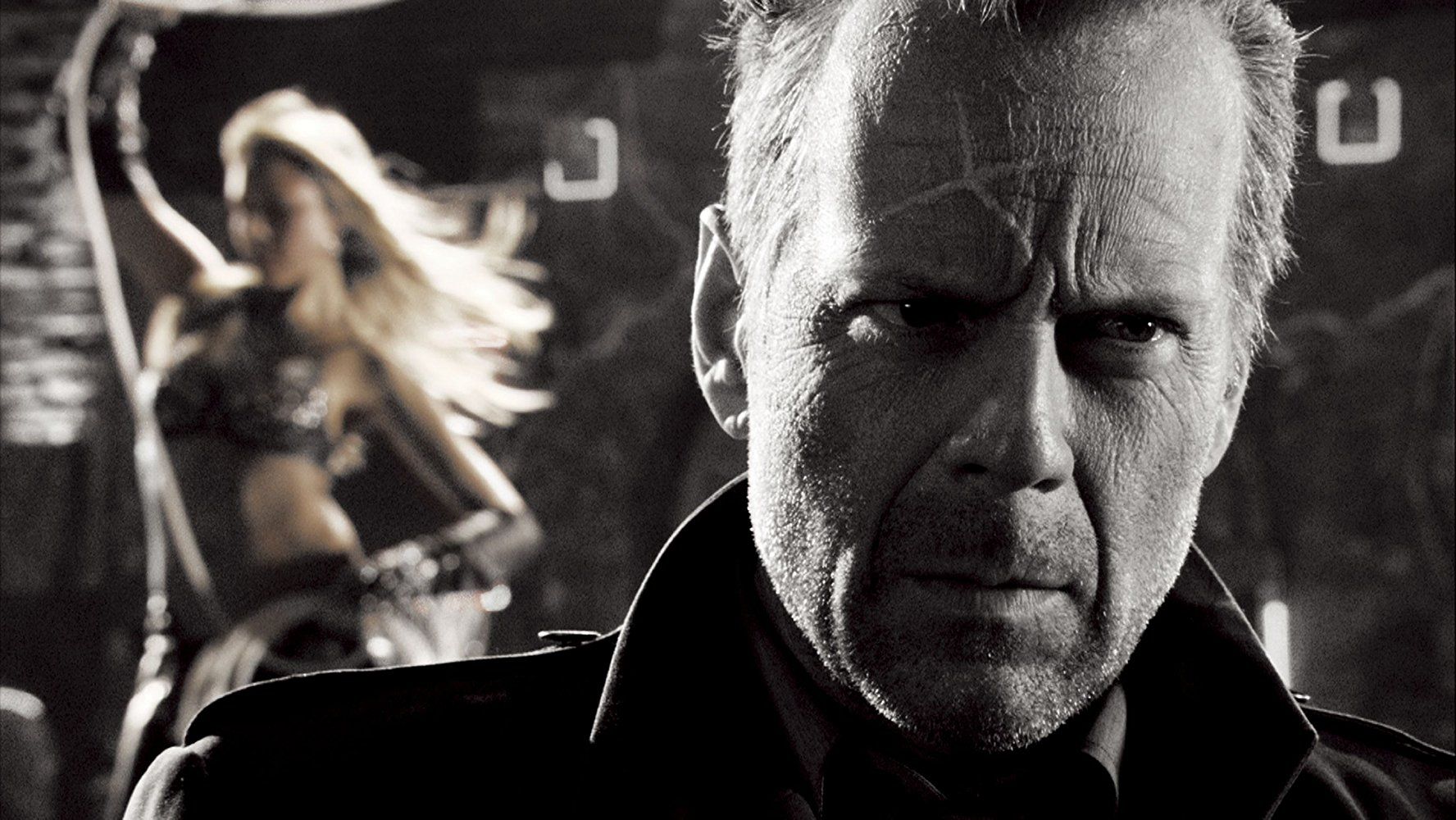
Robert Rodriguez was a huge fan of the Sin City graphic novels. It was he that persuaded Frank Miller to let him make a film of Sin City by shooting a trailer at his own expense. (This appears in the film as the opening teaser The Customer is Always Right featuring Josh Hartnett and Marley Shelton). The trailer so impressed Miller that he immediately signed on. The film adapts three of Miller’s other stories – That Yellow Bastard, The Big Fat Kill and the first published story, which was simply called Sin City in its initial appearance but in subsequent reprints was renamed The Hard Goodbye. (Rodriguez has announced his intention to eventually film all of the Sin City stories).
Rodriguez has modelled the film so closely on the originals strips, using the panels as camera set-ups, that he credits Miller as co-director. In an extraordinary gesture of modesty, Rodriguez was so intent on co-crediting Miller as director that he resigned from the Director’s Guild when they expressed dubiousness about Miller’s credit. Equally, while some of the stories have been trimmed down to fit into the running time, all of the dialogue has been taken directly from what Miller wrote – to such extent that the film bears no credit for a screenplay, merely that it is ‘Based on the Sin City novels by Frank Miller’.
I was completely blown away by Sin City. It is without any doubt the best film that Robert Rodriguez has made to date. We have seen films that have tried to mimic the look of comic-books before – the camp silliness of tv’s Batman (1966-8), the self-conscious effect with which the screen was split up into panels by Ang Lee in Hulk (2003), and more successfully in George A. Romero’s EC Comics homage Creepshow (1982) and in Warren Beatty’s Dick Tracy (1990), which attempted to create the look of a six-colour comic strip on screen. There was also American Splendor (2003) and its unique fusion of graphic novel, staged drama and documentary. With the exception of perhaps Creepshow and American Splendor, this has never managed to seem anything more than a self-conscious affectation.
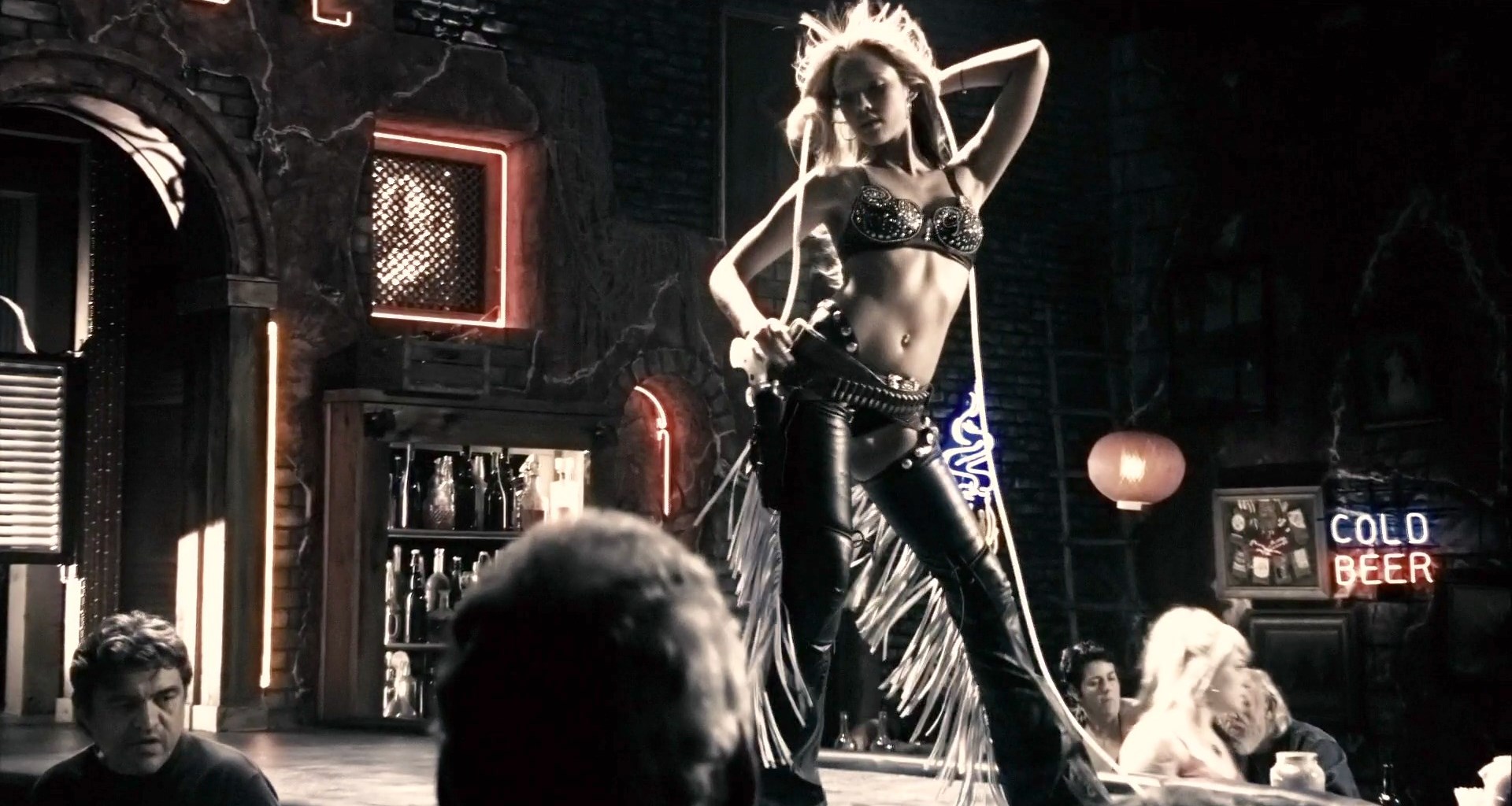
Frank Miller and Robert Rodriguez however turn this into an extraordinary visual style all of its own. The film has been shot on high-definition digital video, which allows Rodriguez to bleed all colour from the frame and mimic the black-and-white look of Frank Miller’s panels with the exception of occasional flashes of tinted colour – the splash of blood, the tail lights of cars, the red of the dress in the first segment, the flash of Wendy’s eyes and of course the sickly golden tint of the Yellow Bastard’s skin, while we also get some aspects – Marv’s bandages, Bruce Willis’s tie, the blood on victims – where the colour comes out as a fluorescent white in sharp contrast to the black on screen.
The visuals are extraordinary – one could easily compare the stylised effect that Robert Rodriguez achieves here with the amazing things you see Orson Welles doing with camera and light when you discover Citizen Kane (1941) for the first time. Rodriguez has also shot almost the entire film in green screen – with about the only set built being that of Kadie’s Bar – and added the rest of the city and its backgrounds digitally. In a number of cases the actors that are reacting together on screen were not present on the same set (and in some cases had not even been cast) when their scenes together were shot and were only digitally merged in post-production.
The one film that one kept being reminded of throughout Sin City was Quentin Tarantino’s Pulp Fiction (1994). Even though Pulp Fiction was made after Frank Miller created the Sin City graphic novels, it has many resemblances to the story structure of the film – three tales where characters keep interweaving, as well as a bookended prologue and epilogue that is woven into the story. Plus, of course, Quentin Tarantino appears here credited as ‘Guest Director’ – he shot the scenes with Benicio Del Toro’s severed head talking to Clive Owen in the car. (A little known fact is that Robert Rodriguez also uncreditedly directed some scenes in Pulp Fiction – the ones where Quentin Tarantino appears on screen – and the two later collaborated on Grindhouse). More importantly, both Pulp Fiction and Sin City take a love of gangster fiction and reinvent it in striking ways with searingly brilliant writing.
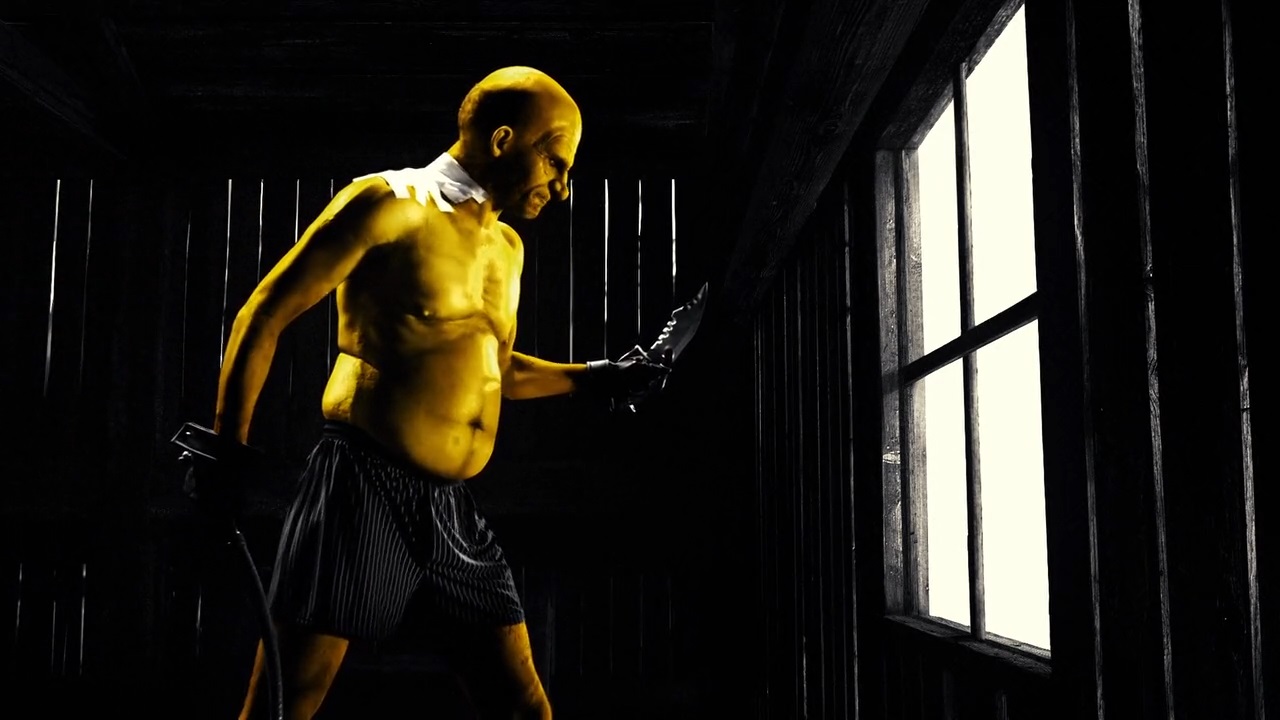
The atmosphere that Sin City evokes is the world of 1940s film noir – a stylised world that seems to be predominantly surrounded by shadows and where the streets course with rain; where heroes are violent, weather-beaten men with burned-out emotions; where women are either idyllic angels or dangerous femme fatales; where cops are either dirty or lone men trying to stand up for something in a corrupt world that is lurking with psychopaths and predators; and where morality is a blurred line filled with people grimly struggling to honour often sentimental promises and make a difference.
Robert Rodriguez has kept Frank Miller’s noir-styled dialogue intact and the genre’s characteristic voiceovers come superbly written. Rodriguez has also kept the ultra-violence of Miller’s graphic novels, which results in one of the most brutal films that one has seen in some time – numerous beatings, bullets through the head, axes to the crotch, severed heads, Bruce Willis ripping off Nick Stahl’s genitalia twice!!!, a victim with her entire hand having been eaten, a suspect being dragged along out of a car door by Mickey Rourke to get information, Elijah Wood tied up with his arms and legs severed and left to be devoured by a wolf, and such like.
One should not go without mentioning the exceptional cast that Rodriguez has managed to array. Almost all present – Bruce Willis, Clive Owen, Jessica Alba, Powers Boothe, Michael Clarke Duncan, Elijah Wood, Carla Gugino, Rutger Hauer, Rosario Dawson – give excellent performances. The one standout performance comes from Mickey Rourke. Covered in a K.N.B. makeup job that bulks him to almost resemble The Incredible Hulk, Rourke is almost entirely unrecognizable on screen and gives a brilliant performance as the brutishly psychopathic killer with the heart of gold. To return to the Pulp Fiction analogies above, one predicts that Sin City is likely to be a role that reinvigorates Mickey Rourke’s career, which has majorly slumped in the last decade, on the order of John Travolta’s performance in Pulp Fiction.
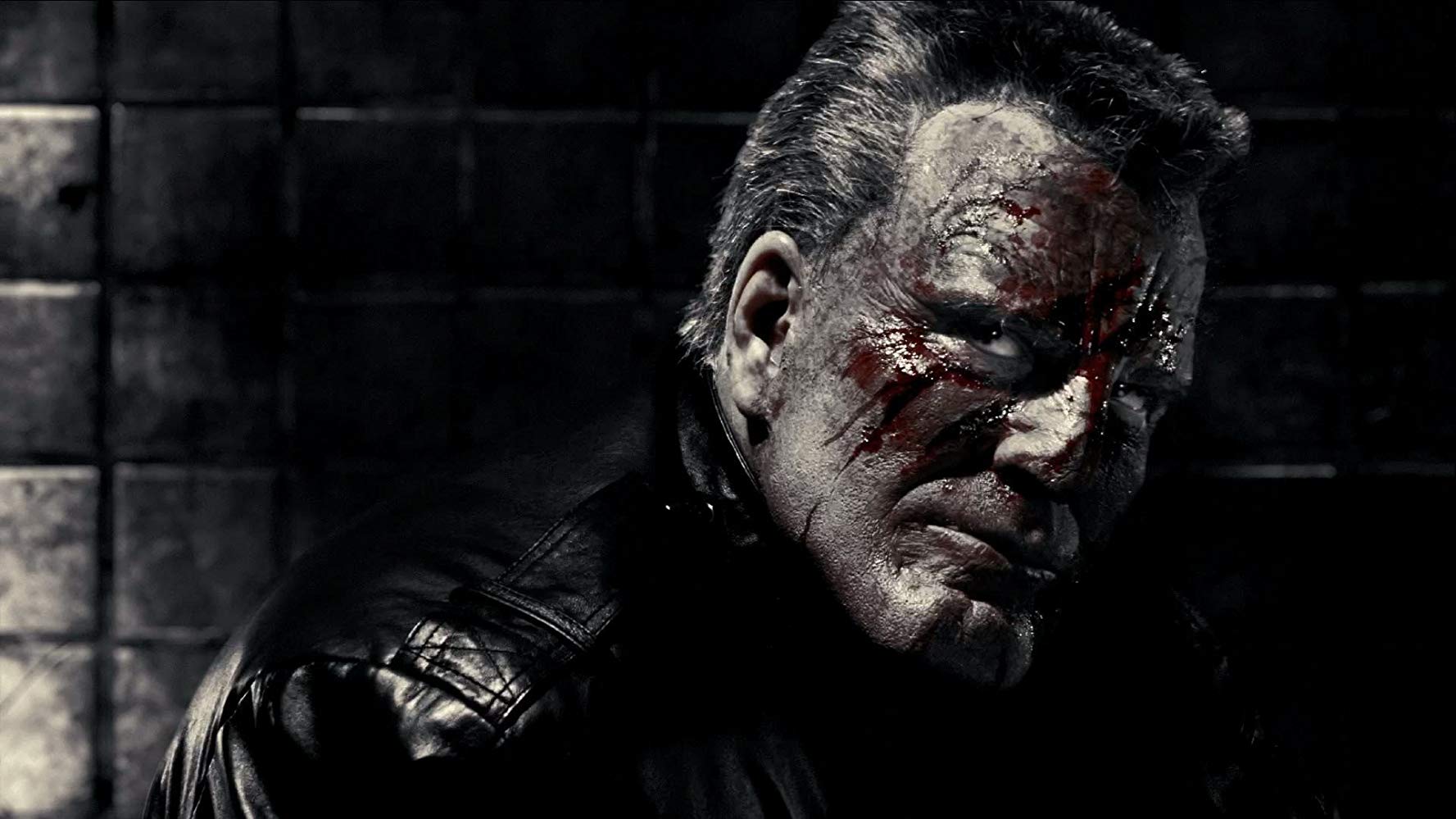
Robert Rodriguez has announced two further Sin City sequels for a number of years. The first of these finally emerged with Sin City: A Dame to Kill For (2014). This met a mixed box-office response casting doubt over the future of any further films.
Robert Rodriguez’s other films of genre interest are the vampire/getaway thriller From Dusk Till Dawn (1996); the witty teen body snatchers film The Faculty (1998); the juvenile spy adventure Spy Kids (2001) and sequels Spy Kids 2: Island of Lost Dreams (2002), Spy Kids 3-D: Game Over (2003), Spy Kids: All the Time in the World (2011) and Spy Kids: Armageddon (2023); the children’s film The Adventures of Sharkboy and Lavagirl in 3-D (2005); the zombie film Planet Terror (2007), half of the Quentin Tarantino collaboration Grindhouse (2007); the children’s film Shorts (2009); Machete Kills (2013), a sequel to his earlier Mexican-themed action film that frequently enters into science-fiction territory; the manga adaptation Alita: Battle Angel (2019); Red 11 (2019), a mind-bending work set during an experimental drug trial; the kid superheroes film We Can Be Heroes (2020); and the reality-bending Hypnotic (2023). Rodriguez has also produced From Dusk Till Dawn 2: Texas Blood Money (1999), From Dusk Till Dawn 3: The Hangman’s Daughter (2000) and Predators (2010), as well as developed the tv series From Dusk Till Dawn (2014-6).
Sin City appears to have made Frank Miller think otherwise about film adaptations and he subsequently okayed the adaptation of 300 (2007), his graphic novel about the Greco-Persian wars of the Fifth Century B.C., which became an adaptation where Zack Snyder pulled off a film that was in every way as visually dazzling as what Robert Rodriguez does here. Miller on his own subsequently went onto direct a film based on the cult comic-book The Spirit (2008) using the same extraordinary visual style here. There was also the animated adaptations of Miller’s classic graphic novels with Batman: Year One (2011), Batman: The Dark Knight Returns Part I (2012), Batman: The Dark Knight Returns Part II (2013) and the tv series Cursed (2020), as well as the sequel 300: Rise of an Empire (2014), and the live-action sequel 300: Rise of an Empire (2014).
(Winner in this site’s Top 10 Films of 2005 list. Winner for Best Directors (Frank Miller, Robert Rodriguez), Best Adapted Screenplay, Best Supporting Actor (Mickey Rourke) and Nominee for Best Cinematography at this site’s Best of 2005 Awards).
Trailer here


